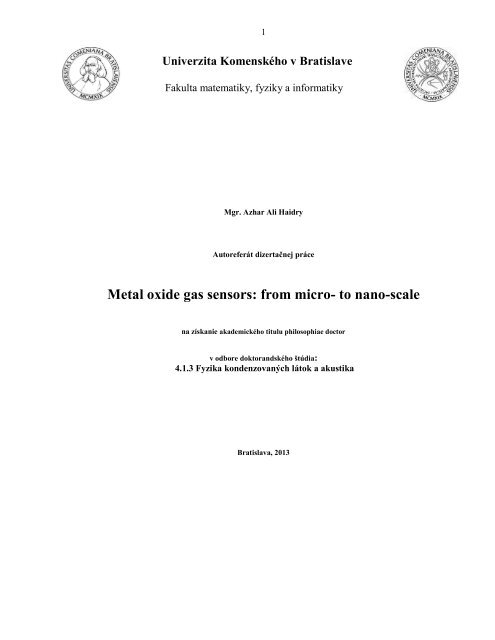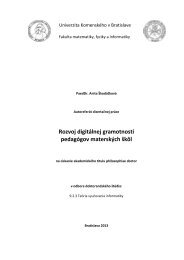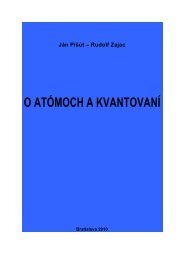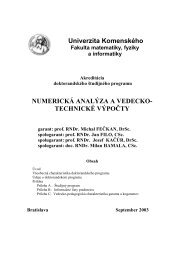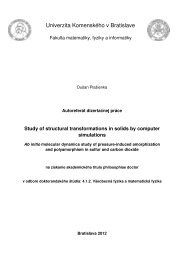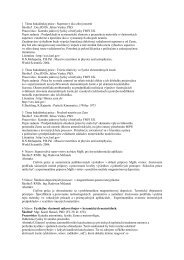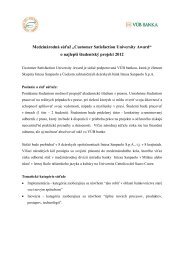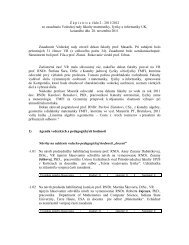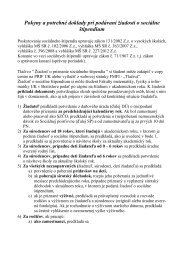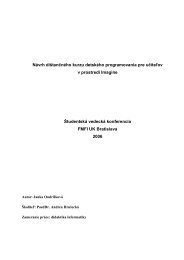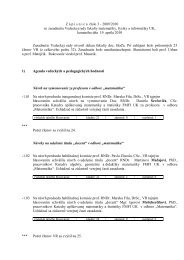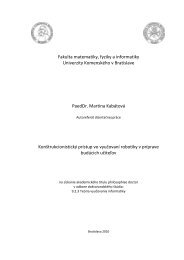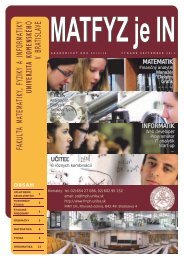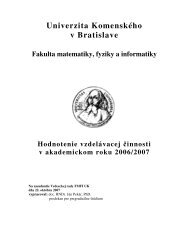Mgr. Azhar Ali Haidry - Fakulta matematiky, fyziky a informatiky ...
Mgr. Azhar Ali Haidry - Fakulta matematiky, fyziky a informatiky ...
Mgr. Azhar Ali Haidry - Fakulta matematiky, fyziky a informatiky ...
You also want an ePaper? Increase the reach of your titles
YUMPU automatically turns print PDFs into web optimized ePapers that Google loves.
1Univerzita Komenského v Bratislave<strong>Fakulta</strong> <strong>matematiky</strong>, <strong>fyziky</strong> a <strong>informatiky</strong><strong>Mgr</strong>. <strong>Azhar</strong> <strong>Ali</strong> <strong>Haidry</strong>Autoreferát dizertačnej práceMetal oxide gas sensors: from micro- to nano-scalena získanie akademického titulu philosophiae doctorv odbore doktorandského štúdia:4.1.3 Fyzika kondenzovaných látok a akustikaBratislava, 2013
2Dizertačná práca bola vypracovaná v dennej forme doktorandského štúdia na Katedre experimentálnej <strong>fyziky</strong>,FMFI, Univerzity Komenského v Bratislave.Predkladateľ:<strong>Mgr</strong>. <strong>Azhar</strong> <strong>Ali</strong> <strong>Haidry</strong>Katedre experimentálnej <strong>fyziky</strong>Faculta Matematiky, Fyziky a InformatikyMlynská dolina F2, 842 48 BratislavaŠkoliteľ:Prof. RNDr. Andrej Plecenik, DrSc.Katedre experimentálnej <strong>fyziky</strong>Faculta Matematiky, Fyziky a InformatikyMlynská dolina F2, 842 48 BratislavaOponenti: ............................................................................................................................................................................................................................................................................................................Obhajoba dizertačnej práce sa koná ..................... o ............. hpred komisiou pre obhajobu dizertačnej práce v odbore doktorandského štúdia vymenovanou predsedomodborovej komisie ........................................(uviesť dátum vymenovania).... 4.1.3 Fyzika kondenzovaných látok a akustika............na ........ Faculte Matematiky, Fyziky a Informatiky, Mlynská dolina F2, 842 48 Bratislava.............Predseda odborovej komisie:Prof. RNDr. Peter Kúš, DrSc.Katedra experimentálnej<strong>fyziky</strong>, FMFI UK Mlynskádolina F2, 842 48 Bratislava
3AbstractThe increasing demand to develop low-cost, highly sensitive and selective gassensors in various industrial applications is a challenging task for scientists. Particularlymetal oxide (MOX) gas sensors are becoming popular due to their good sensing propertiesand durability. Selectivity and relatively high operating temperature are among their maindrawbacks. In this research various gases were analyzed but the main focus was to detecthydrogen gas at room temperatures to save power consumption. Over the last decade, thefuel cell industry is aiming to carry out hydrogen gas as a fuel but last few years were realboost towards the use of hydrogen as a fuel. Hydrogen gas production and storage is in itsadvance stage while its detection especially at room temperature is a big issue for scientistsworking in gas sensing R&D because of its explosive nature when mixed with air. In thisresearch work we focused on developing the gas sensors based on TiO 2 thin films workingat temperatures lower than 200 °C.In the first part of this research we used DC magnetron sputtering and sol-gelmethod to deposit the TiO 2 thin films on sapphire substrate. The effect of post-depositionannealing temperature (600 – 1000 °C) on structural, morphological and gas sensingproperties were studied. Crystal structure, surface topography and optical properties of thethin films have been studied by X-ray Diffraction technique, Atomic Force Microscopyand UV-VIS Spectroscopy. From X-ray Diffraction analysis it was found that the phase ofthe films changed from anatase to rutile, this transformation occurred at 700 – 800 °C and800 – 900 °C for the films prepared by DC magnetron sputtering and sol-gel methodrespectively. The grain size and roughness tended to increase with increasing postannealingtemperature. The band-gap energies of the films tended to decrease withincreasing annealing temperature what related with the phase transformation from anatase(E g = 3.2 eV) to rutile (E g = 3.0 eV ). The comb-like Pt electrodes (with a spacing of tenmicro-meter) were prepared by standard photolithography for electrical measurements and
4the films were exposed to different concentrations of H 2 /Air gas up to 10,000 ppm insynthetic air at various operating temperatures. It was found that the films prepared by DCmagnetron sputtering showed high sensitivity (S = R air / R gas > 10 5 ) towards 10,000 ppmhydrogen gas in synthetic air when annealed at 700 °C (anatase) with operatingtemperature lower than 200 °C. On the other hand, the films prepared by sol-gel methodshowed high sensitivity (S > 10 4 ) towards 10,000 ppm H 2 when annealed at 900°C (rutile)with operating temperature lower than 220 °C.The results from first part of this research work showed that the sensors can work atoperating temperature lower than 200 °C but the planner comb-like structures limited theiruses as having very low sensitivity and high resistivity at room temperature. The secondpart of the research work was devoted to develop top-bottom electrode configuration forthe detection of various gases including humidity. Thin films of TiO 2 were sandwiched asgas sensing layer between top and bottom Pt electrodes. This specific electrodeconfiguration showed improved gas sensing properties and allowed us to detect variousconcentrations of hydrogen gas at room temperature. The sensors were exposed to othergases (CO, O 2 /N 2 , H 2 S) also but showed very little response most probably resulting in theincreased selectivity towards hydrogen gas. The sensor configuration showed highsensitivity (S > 10 4 ) towards 10,000 ppm of hydrogen gas at room temperature. Thesensitivity was further enhanced (S > 10 6 at 50 °C and S > 10 7 at 100 °C) for 10,000 ppmof hydrogen gas. The sensor configuration showed fast response and recovery time even atroom temperature. Although recently the sensing layers are frequently replaced bynanostructured materials (nanowires, nanotubes, nanobelts etc.), the development of newand improved thin-film sensors is still important since they can be prepared by cheap andsimple methods.Keywords: TiO 2 anatase/rutile; reactive sputtering method; H 2 gas sensor; MOX
6Výsledky z prvej časti ukázali možnosť prípravy senzorov s prevádzkovou teplotoumenšou ako 200°C. Planárne hrebeňové štruktúry limitovali ich vlastnosti senzorov aspôsobili nízku citlivosť a vysoký odpor pri izbovej teplote. V druhej časti sa venujemevýskumu senzorov s vertikálnymi elektródami na detekciu rôznych plynov vrátanevlhkosti. Sendvičová štruktúra je tvorená tenkou vrstvou TiO 2 medzi dvomi Ptelektródami. Pri tejto konfigurácii elektród boli dosiahnuté lepšie senzorické vlastnosti abolo možné detegovať rôzne koncentrácie vodíka pri izbovej teplote. Citlivosť na inéplyny (CO, O 2 /N 2 , H 2 S) bola nízka, čo bolo pravdepodobne spôsobené zvýšenouselektivitou na vodík. Bola nameraná vysoká citlivosť (S > 10 4 ) na vodík pri izbovejteplote. Pri koncentrácii vodíka 10 000 ppm bola citlivosť ešte vyššia (S > 10 6 pri 50 °Cand S > 10 7 pri 100 °C). Senzor mal aj pri izbovej teplote krátku reakčnú dobu a dobuzotavenia. Napriek tomu, že sa senzorické vrstvy často nahrádzajú nanoštruktúrami(nanotrúbky, nanodrôty, atď), vývoj nových a vylepšených senzorov na báze tenkýchvrstiev je stále dôležitý, keďže ich výhodou je lacná a jednoduchá výroba.Kľúčové slová: TiO 2 anatáz/rutil; reaktívne naprašovanie, vodíkový senzor; MOX
8recognizes that chemical substance and then transducer converts that stimuli into an outputsignal (generally electrical); receptor and transducer functions will be discussed later indetails. Gas sensors belong to the category of chemical sensors, where the sensors canidentify a chemical substance in gaseous form (H 2 , CO, CO 2 , H 2 S and etc.). Among others,metal oxide (MOX) gas sensors have been widely utilized and are known as resistive (orchemiresistive) gas sensors since their resistance (or conductance) is changed uponexposure to a chemical substance in gaseous form [1 – 7].1.2. H 2 interaction with TiO 2The hydrogen adsorption on TiO 2 surface, nowadays, is utilized in fabricatinghydrogen gas sensors [1, 8 – 10]. The adsorption of hydrogen gas at TiO 2 results in theformation of hydroxyl or hydride compounds [11]; here oxygen vacancies (act as electrondonors) are specific adsorption sites for H 2 gas. In general, the interaction of reducinggases with MOX (like TiO 2 ) is described by two models [6, 7]. In first model, so-called“ionosorption model”, the change in conductivity (sensor response) of MOX based sensorsis explained in terms of the reaction of gases with pre-adsorbed oxygen at the surface. Thesecond model is based on partial reduction and re-oxidation of MOX films upon exposureto a gas and is known as “oxygen-vacancy model”. Since ionosorption model is widelyaccepted and explains many features of MOX based sensors, however many issues havebeen found experimentally and theoretically with both models. In the following sectiononly sensing mechanism of n-type TiO 2 will be discussed for analyzing H 2 reducing gas.In ionosorption model, the sensing mechanism of n-type TiO 2 thin films to areducing gas (H 2 , CO etc.) can be explained by interaction of reducing gas moleculeswith the pre-adsorbed oxygen (O 2 - , O - , O 2- ) at the surface, fig. 1.1. The adsorbed oxygendecreases (in the case of n-type TiO 2 ) the conductivity of the MOX film by trappingelectrons from the surface and forming a depleted surface layer. The oxygen can bedesorbed by introducing a reducing gas, such as hydrogen, according to the followingequations [2, 8]:2H 2 + O 2-(ads) → 2H 2 O (des) + e -H 2 + O - (ads) → H 2 O (des) + e - (1.1)H 2 + O 2- (ads) → H 2 O (des) + 2e -
9For n-type TiO 2 , it means that the resistance of the sensor tends to decrease as theinteraction of hydrogen gas with pre-adsorbed oxygen leads to freeing of previouslytrapped conduction electrons.As the form (O - 2 , O - , O 2- ) and number of adsorbed oxygen given by adsorption anddesorption kinetics on the sensor surface changes with varying temperature in general [12],this results in different sensing characteristics at different operating temperatures. For thesereactions, the concentration of pre-adsorbed oxygen remains constant and higher than theconcentration of H 2 gas molecules [2].Figure 1.1: Showing the surface reaction mechanism of TiO 2 thin film withH 2 gas molecules, also the band bending at grain boundaries. Left: The Surfacereaction mechanism (The interaction of H 2 (gas) with pre-adsorbed oxygenforming H 2 O (gas) molecules) and the measuring schematic of electricresponse of the thin films. Right-(a): Showing the height of potential barrier inair (eV s(air) ) resulting due to the trapping of electrons by adsorbed oxygenspecies on the MOX surface. (b): The reduced height of potential barrier(eV s(gas) ) after the reducing gas (e.g. H 2 ) is allowed to enter into the chamber,which then reacts with adsorbed oxygen resulting in the release of trappedelectron on the surface to the conduction band.According to oxygen-vacancy model [13, 14] the point defects (oxygen vacancies)are the determining factor, where oxygen vacancies act as electron donors. When areducing gas (H 2 or CO) is introduced to MOX layer containing oxygen vacancies, the
10surface of n-type MOX is partially reduced allowing the introduction of more oxygenvacancies. As a result H 2 O or CO 2 is formed in gaseous form and the number of freeelectrons at the surface is increased, which then decreases the MOX layer resistivity. Oncereducing gas is stopped and oxygen rich environment is provided, the surface is returned toits re-oxidized state by filling in the oxygen vacancies and thereby trapping the freeelectrons again to increase the resistivity of the MOX layer. For oxidizing gases (NO x , SO xetc) one can proposed opposite sensing mechanism.1.3. Theses1. Preparation and characterization of TiO 2 thin films by dc magnetron sputteringand sol-gel method.2. Effect of post-deposition annealing on structural, optical and gas sensingproperties of the TiO 2 thin films.3. Effect of contact preparation processes on the sensing properties of these films.4. Novel top-bottom electrode configuration for metal oxide semiconducting thinfilms having improved sensitivity at room temperature.
12A mixture of 3.8 ml of ethanol with 0.7 g of Triton X-100 was mixed under ambientconditions for 3 min. Then 0.68 ml of acetic acid and 0.36 ml of Ti (IV) isopropoxide wereadded. The spin-coating procedure was repeated three times using a velocity of 3000 rpmwith short intermediate heating at 550 °C.TiO 2 films deposited by both methods were ex-situ annealed in air in temperaturesrange of 600 to 1000 °C for 1 hour in MTI GSL-1600X-S60 tube furnace with power 14kW. The samples are placed on alumina ceramic and inserted in alumina tube. This furnacecan be used to anneal the samples at maximum temperature 1600 °C. This furnace isprogrammed so that various ramping rates can be used to increase or decrease thetemperature, in this work we used fixed ramping rate of 100 °C per 15 min. The furnace isequipped with MoSi 2 heating elements, a thermocouple (Pt-Rh thermocouple) and thyristorpower regulator.The XRD measurements of our thin films were performed by standard Bragg-Brentano (XRD), using URD8 diffractometer with a CuKα radiation (λCuK α = 0.15418nm) and the graphite curved monochromator. In order to avoid strong substrate diffractionin Bragg-Brentano measurement we used slight angular offset of the sample position∆θ~1° for samples of TiO 2 grown on monocrystalline substrates. Since September 2011,the structural investigation of the TiO 2 thin films was performed by XRD on X’Pert ProMRD diffractometer (PANalytical) with a CuKα radiation λ CuKα = 0.15418 nm at powersettings 45 kV, 40 mA. For phase analysis θ/2θ spectra was measured and compared withthe nominal bulk data in the range of 20° – 95°.In GID method we have used fixed low incidence angle of around 1° usingincidence beam parabolic mirror producing low divergence (0.05°) parallel primary beam.The incidence angle was optimized at the first diffraction position of TiO 2 layer formaximum intensity. For suitable angular resolution in GID we used a parallel platecollimator (divergence of 0.18°) in front of detector. For the step size of 0.05° the countingtime was 10 s.Scanning Electron Microscope TESCAN TS 5136 MM was employed to determinethe film thickness and also for observing the surface of the thin films.The surfacetopography of the films was analyzed by Atomic Force Microscope (AFM) NT-MDT
13Solver P47 PRO in semi–contact mode mounted with standard Si tips were used. Theaverage surface roughness S A was calculated as standard deviation of height h adopting theformula: , where h i is height of the i th point, is average height andN is number of points. In our laboratory, the optical spectra were obtained by spectrometerSPECORD UV VIS (Carl Zeiss Jena), measured in the range 300 nm – 700 nm.The X-ray photoelectron spectroscope (XPS) measurements were carried out at ourdepartment with Omicron multi-probe system from Omicron NanoTechnology GmbH,Germany. The system is equipped with a monochromatic Al-Kα (1486.6 eV) x-rays sourcewith twin anode (Model: XM 1000), Ar ion gun with energy of ions 2 keV and ahemispherical electron energy analyzer. The pressure in the chamber system is around 10 -10 mbar. The Spectra were measured at ambient temperature with photoemission 45 degreefrom the surface. To minimize effects of charging at the TiO 2 film, a low-energy electrongun was used for charge neutralization. The atomic concentrations analysis of the filmswas calculated using CasaXPS software from appropriate peak area. A part of chemicalcomposition of the films was analyzed at BIONT a.s. by AES from Russia (type AES09IOS-10-005). To obtain depth profile, the sample surface was simultaneously etched byAr ion gun.Subsequently a Pt thin film of 20 nm thickness was deposited by dc magnetronsputtering. Standard photolithography and subsequent Ar ion beam etching was then usedto pattern comb-like Pt micro-structures with 10 µm distance between the electrodes.A computer-controlled experimental setup was used for the electrical and gasresponsemeasurements, fig. 2.1. All measurements were done in a sealed chamber(volume of 300 cm 3 ) in flow regime of the synthetic dry air at the rate 0.1 l/min. Amountof gas flowing to the chamber was controlled by two gas flow controllers, Red-y SmartMass Flow Meter and Controller by Icenta Controls Ltd., one for synthetic air and one forsynthetic air with 1% of H 2 with ranges of 15–500 sccm and 3–100 sccm (standard cubiccentimeters per minute), respectively. The sample was mounted on a Boraelectric heatingelement from Advanced Ceramics Corp. with a K-type thermocouple inside. DC powersupplied to the heater was regulated by PID algorithm to maintain the desired temperatureon the thermocouple. The electrical resistivity of the TiO 2 thin films was measured by aKeithley 6487 Picoammeter/Voltage Source. Resistance versus temperature (RT)measurements were performed in temperature range from 250 to 350 °C, while the gas
14sensing measurements were done at temperatures from 24 °C to 350 °C. This setup allowsus to measure resistance of TiO 2 thin films up to 10 11 Ohms at various H 2 concentrationsfrom 10 ppm to 10,000 ppm (Parts per million) and various operating temperatures up to350 °C.Fig. 2.1: Shows the experimental setup for measuring the gas sensingproperty and electrical measurement of the samples
3 – Results and Discussions15In this work, we have studied the gas sensing applications of TiO 2 thin films. In thefirst part of this project, we have investigated the effect of post-deposition annealingtreatment on structural, morphological, optical and gas sensing properties of TiO 2 thinfilms [8 – 10]. Then, we have also investigated the effect of contact preparation process ongas sensing properties of these films. In the second part of the project, we have proposednovel top bottom electrode (TBE) configuration for these films, which can detect hydrogengas at room temperature. Here, we will present only few selected results due to limitationsof number of pages. Titanium dioxide thin films with thickness 100 nm were prepared bythe reactive dc magnetron sputtering and solgel method. The thin films were deposited onsapphire substrate from a titanium target in an oxygen atmosphere. Also, thin films oftitanium dioxide with thickness of about 150 nm were deposited by spin coating method ona sapphire substrate from a sol-gel. The samples were then post-annealed in air in thetemperature range 600 °C – 1000 °C. It was found that the phase gradually changed fromanatase to rutile, the grain size and roughness tended to increase with increasing postannealingtemperature. The phase transformation from anatase to rutile for our thin filmsprepared by DC magnetron sputtering and solgel route took place at 800 °C and 900 °Cannealing temperature respectively.Fig. 3.1: Detail of XRD spectra of the TiO 2 films. The typical XRD diffractograms forTiO 2 thin films prepared by DC magnetron sputtering process (Left) and solgel process(Right), which were subsequently annealed at temperature ranges from 600 ºC to 1000 ºC.
16Fig. 3.2: AFM topography of the TiO 2 thin films prepared by DC magnetronsputtering method. AFM topography of TiO 2 thin films (a) 600 ºC, (b) 700 ºC,(c) 800 ºC, (d) 900 ºC and (e) 1000 ºC. (f) Optical microscope photograph ofthe comb-like Pt electrodes applied on the surface of thin films to measureelectrical response.Fig. 3.3: AFM topography of the TiO 2 thin films prepared by solgel method.AFM topography of TiO 2 thin films (a) 600 ºC, (b) 700 ºC, (c) 800 ºC, (d)900 ºC and (e) 1000 ºC. The grain size and roughness of the thin filmstended to increase with increasing the annealing temperature.
17The surface morphology and roughness were analyzed by AFM (Fig. 3.3and3. 4). The AFM images of the TiO 2 thin films post–annealed at higher temperatureswere characterized by the presence of rather large grains having size over 1 µm. At lowerannealing temperatures, the AFM shows nano-crystalline surface with grain size up to 100nm. It was observed that the grain size and roughness of the thin films tended to increaseby increasing the annealing temperature (Fig. 3.3 and 3.4).The Arrhenius plots were obtained from resistance versus temperature graphsperformed in synthetic air at a rate of 0.2 °C/s in the temperature range 250 °C to 350 °C(Fig. 3.4/left and 3.5/left). The exponential decrease in the resistivity with temperature wasfound in this range satisfying the equation: where is the Boltzmann constant, T is the absolute temperature and is the activationenergy for overcoming potential barrier between grains.Figure 3.4: The Arrhenius plots for the TiO 2 thin films deposited by DCmagnetron sputtering process (Left). Plot of the ln R air vs. the reciprocaltemperature constructed from R-T measurements recorded in thetemperature range 250 °C to 350 °C. The plot of sensitivity vs. annealingtemperature, measured for 10000 ppm of H 2 concentration at operatingtemperature T op = 300 °C (circles) in comparison with plot of E A (squares)(Right). Inset shows the correlation between sensitivity S and E A .
18Figure 3.5: The Arrhenius plots for the TiO 2 thin films deposited by spincoating of solgel system (Left). The effect of annealing temperature on theproperties (sensitivity, surface roughness and activation energy) of TiO 2 thinfilms (Right).4. SummaryIn case of TiO 2 thin films prepared by DC magnetron sputtering, we have founddirect correlation between the sensitivity and activation energy E A obtained fromArrhenius plots corresponding to temperature range 250 ÷ 350 °C, it was observed that thesamples with lowest value of E A = 0.318 eV (annealed at 700 °C) has the highestsensitivity (Fig. 3.4/Right). While for TiO 2 thin films prepared via solgel system: the filmsannealed at 600, 700 and 800 °C showed relatively low sensitivity to hydrogen gas(2.9×10 2 , 1.3×10 1 and 1.0×10 1 respectively for 10 000 ppm of H 2 ) , while sensitivity ofthe films annealed at 900 and 1000 °C was considerably higher (S = 5×10 4 and 8×10 3respectively), fig. 3.5/Right. We propose that the increase of sensitivity of these films canbe at least partially related to increased surface roughness offering more adsorption sites.AcknowledgementsThe work was supported by the Slovak Research and Development Agency under thecontracts No. VVCE-0058-07, APVV-0034-07, APVV-0432-07, DO7RP-007-09 and LPP-0176-09, by the Ministry of Education of the Slovak Republic under the contract VEGA
191/0605/12, VEGA 1/1072/11 and is also the result of the project implementation:26240120012 supported by the Research & Development Operational Programme fundedby the ERDF.References[1] T. Hubert, L. Boon-Brett, G. Black and U. Banach, Hydrogen gas sensors–A review, Sensors and Actuators B 157 (2011), pp. 329 – 352.[2] K. Zakrzewska, Titanium Dioxide Thin Films for Gas Sensors and PhotonicApplications, AGH Ucelniane Wydawnictwa Naukowo-Dydadaktyczne,Kraków 2003.[3] D. K. Aswal and S. K. Gupta, Science and technology of chemiresistive gassensors, Nova Science Publishers: New York, NY, USA, 2007.[4] N. Barsan, D. Koziej, U. Weimer, Metal oxide-based gas sensor research:How to, Sensors and Actuators B 121 (2007), pp. 18 – 35.[5] Noboru Yamazoe and Kengo Shimanoe, Theory of power law for metaloxide, Sensors and Actuators B 128 (2008), pp. 566 – 573.[6] A. Gurlo and R. Riedel, In Situ and operando spectroscopy for assessingmechanisms of gas sensing, Angew. Chem. Int. Ed 2007, 46, pp. 3826 –3848.[7] A. Tricoli, M. Righettoni, A. Teleki, Semiconductor gas sensors: Drysynthesis and application, Angew. Chem. Int. Edit. 2010, 49, pp. 7632 –7659.[8] A.A. <strong>Haidry</strong> et al., Hydrogen gas sensors based on nanocrystalline TiO 2 thinfilms, Central European Journal of Physics, 9 (2011), pp. 1351 – 1356.[9] A. A. <strong>Haidry</strong> et al., Characterization and hydrogen gas sensing properties ofTiO 2 thin films prepared by sol - gel method, Applied Surface Science 259(2012), pp. 270 – 275.[10] A. A. <strong>Haidry</strong> et al., Effect of post-deposition annealing treatment on thestructural, optical and gas sensing properties of TiO 2 thin films. KeyEngineering Materials 510-511 (2012), pp. 467-474.
20[11] S. Suzuki et al., Hydrogen adatoms on TiO 2 (110)-(1x1) characterized byscanning tunneling microscopy and electron stimulated desorption, Phys.Rev. Lett. 2000 Mar 6, 84(10), pp. 2156-9.[12] N. Barsan and U. Weimer, Conduction Model of Metal Oxide Gas Sensors,Journal of Electroceramics, 7(2001), pp. 143 – 167.[13] X. Du et al., CO Gas Sensing by Ultrathin Tin Oxide Films Grown byAtomic Layer Deposition Using Transmission FTIR Spectroscopy, J. Phys.Chem. A 112 (2008), pp. 9211 – 9219.[14] S. Zhang et al., A reaction model of metal oxide gas sensors and arecognition method by pattern matching, Sensors and Actuators B 135(2009), pp. 552–559.[15] F. Santerre, M.A. El Khakani, M. Chaker, J.P. Dodelet, Properties of TiCthin films grown by pulsed laser deposition, Appl. Surf. Sci., 148 (1999),pp. 24.[16] M. Miura, T.Matsuda, M. Ueda, Y. Satoh, O. Ikata, Y. Ebata, and H.Takagi,Temperature compensated LiTaO 3 /sapphire saw substrate for high powerapplications”, IEEE Ultrason. Symp. 2005, pp.573 – 576.[17] Kevin W. Kirby (2008), Processing of sapphire surfaces for semiconductordevice applictions, M.Sc. Thesis, The Graduate School, College ofEngineering, The Pennsylvania State University.[18] E. Stathatos, P. Lianos, and C. Tsakiroglu, Highly efficient nanocrystallineTitania films made from organic/inorganic nanocomposite gels,Microporous Mesoporous Materials 75 (2004), pp. 255 – 260.[19] P. Bouras, E. Statathos, P. Lianos, and C. Tsakiroglou, Photodegradation ofBasic Blue by highly efficient nanocrystalline titania films, Applied Catal.B 51 (2004), pp. 275 – 281.
21UNIVERZITA KOMENSKÉHOFAKULTA MATEMATIKY, FYZIKY A INFORMATIKYZoznam publikačnej činnosti<strong>Mgr</strong>. <strong>Azhar</strong> <strong>Ali</strong> <strong>Haidry</strong>ADC Vedecké práce v zahraničných karentovaných časopisochADC01 <strong>Haidry</strong>, <strong>Azhar</strong> <strong>Ali</strong> 15% - Schlosser, Peter 10% - Ďurina, Pavol 10% - Mikula,Marián 10% - Tomášek, Milan 10% - Plecenik, Tomáš 10% - Roch, Tomáš 5% -Pidík, Andrej 5% - Štefečka, Miloslav 5% - Noskovič, Jaroslav 5% - Zahoran,Miroslav 5% - Kúš, Peter5% - Plecenik, Andrej 5%: Hydrogen gas sensors based onnanocrystalline TiO(2) thin filmsLit. 19 zázn.In: Central European Journal of Physics. - Vol. 9, No. 5 (2011), s. 1351-1356ADC02 <strong>Haidry</strong>, <strong>Azhar</strong> <strong>Ali</strong> 20% - Puškelová, Jarmila 10% - Plecenik, Tomáš 10% -Ďurina, Pavol 10% - Greguš, Ján 10% - Truchlý, Martin 10% - Roch, Tomáš 5% -Zahoran, Miroslav 5% - Vargová, Melinda 5% - Kúš, Peter 5% - Plecenik, Andrej 5%- Plesch, Gustáv 5%:Characterization and hydrogen gas sensing properties of TiO2thin films prepared by sol gel methodLit. 32 zázn., 7 obr., 1 tab.In: Applied Surface Science. - Vol. 259 (2012), s. 270-275ADC03 Roch, Tomáš 25% - Dobročka, Edmund 20% - Mikula, Marián 15% - Pidík,Andrej 5% - Ďurina, Pavol 5% - <strong>Haidry</strong>, <strong>Azhar</strong> <strong>Ali</strong> 5% - Plecenik, Tomáš 5% -Truchlý, Martin 5% - Grančič, Branislav 5% - Plecenik, Andrej 5% - Kúš, Peter 5%:Strong biaxial textureand polymorph nature in TiO2 thin film formed by ex-situannealing on c-plane Al2O3 surfaceLit. 36 zázn., 7 obr.In: Journal of Crystal Growth. - Vol. 338, No. 1 (2012), s. 118-124ADE Vedecké práce v zahraničných nekarentovaných časopisochADE01 <strong>Haidry</strong>, <strong>Azhar</strong> <strong>Ali</strong> 15% - Ďurina, Pavol 10% - Tomášek, Milan 10% - Greguš, Ján10% - Schlosser, Peter 10% - Mikula, Marián 10% - Truchlý, Martin 5% - Roch,Tomáš 5% - Plecenik, Tomáš 5% - Pidík, Andrej 5% - Zahoran, Miroslav 5% - Kúš,Peter 5% - Plecenik, Andrej 5%: Effect of post-deposition annealing treatment on thestructural, optical and gas sensing properties of TiO2 thin films
22Lit. 22 zázn.In: Key Engineering Materials. - Vol. 510-511 (2012), s. 467-474ADE02 Plesch, Gustáv 9% - <strong>Haidry</strong>, <strong>Azhar</strong> <strong>Ali</strong> 9% - Gregor, Maroš 9% - Ďurina, Pavol7% - Greguš, Ján 6% - Truchlý, Martin 6% - Roch, Tomáš 6% - Plecenik, Tomáš 6%- Zahoran, Miroslav 6% - Puškelová, Jarmila 6% - Mikula, Marián 6% - Grančič,Branislav 6% - Satrapinský, Leonid 6% - Kúš, Peter 6% - Plecenik, Andrej 6%:Structure of hydrogen gas sensing TiO2 thin films prepared by sol - gel method andtheir comparison with magnetron sputtered filmsLit. 10 zázn., 2 obr.In: Key Engineering Materials. - Vol. 543 (2013), s. 293-296AFC Publikované príspevky na zahraničných vedeckých konferenciáchAFC01 <strong>Haidry</strong>, <strong>Azhar</strong> <strong>Ali</strong> 15% - Ďurina, Pavol 10% - Truchlý, Martin 10% - Satrapinský,Leonid 10% - Plecenik, Tomáš 10% - Mikula, Marián 10% - Grančič, Branislav 5% -Roch, Tomáš 5% - Tomášek, Milan 10% - Gregor, Maroš 5% - Kúš, Peter 5% -Plecenik, Andrej5%: Studies of hydrogen gas sensing properties of anatase TiO2 thinfilms prepared by magnetron sputteringLit. 7 zázn.In: IMCS 2012 : The 14th International Meeting on Chemical Sensors. - Wunstorf :AMA Service GmbH, 2012. - S. 1271-1274. - ISBN 978-3-9813484-2-2[IMCS 2012 : Chemical Sensors : International Meeting. 14th, Nuremberg, 20.-23.5.2012]AFD Publikované príspevky na domácich vedeckých konferenciáchAFD01 Puškelová, Jarmila 25% - <strong>Haidry</strong>, <strong>Azhar</strong> <strong>Ali</strong> 25% - Ďurina, Pavol 25% - Truchlý,Martin 25%: Tenké vrstvy pre vodíkové senzory pripravené sól-gélovou metódou nabáze TiO2 dopovaného Cu a AgLit.: 5 zázn., 2 obr.In: Pokroky v anorganickej chémii. - Bratislava : UK, 2012. - S. 82-84. - ISBN 978-80-223-3258-3[Pokroky v anorganickej chémii : Seminár. 9., Modra-Piesok, 18.-21.6.2012]AFD02 Puškelová, Jarmila 25% - <strong>Haidry</strong>, <strong>Azhar</strong> <strong>Ali</strong> 25% - Ďurina, Pavol 25% - Truchlý,Martin 25%: Príprava a štúdium vodíkových senzorov na báze TiO2Lit. 3 zázn., 3 obr.In: Študentská vedecká konferencia PriF UK 2012. Zborník recenzovanýchpríspevkov [elektronický zdroj]. - Bratislava : Univerzita Komenského, 2012. - S.993-996 [CD-ROM]. - ISBN 978-80-223-3213-2[Študentská vedecká konferencia PriF UK 2012. Bratislava, 25.4.2012]AFG Abstrakty príspevkov zo zahraničných konferencií
23AFG01 <strong>Haidry</strong>, <strong>Azhar</strong> <strong>Ali</strong> 100%: Synthesis and characterization metal oxidesemiconductor thin films for hydrogen gas sensing applicationsIn: SURFINT - SREN III : Progress in Applied Surface, Interface and Thin FilmScience 2012. - Bratislava : Comenius University, 2012. - S. 87. - ISBN 978-80-223-3212-5[SURFINT - SREN 2012 : Progress in Applied Surface, Interface and Thin FilmScience : Conference. 3rd, Florence, 14.-18.5.2012]AFG02 Kondela, Tomáš 25% - Greguš, Ján 25% - Schlosser, Peter 10% - <strong>Haidry</strong>, <strong>Azhar</strong><strong>Ali</strong> 15% - Amin, Gamal A. M. 5% - Roch, Tomáš 5% - Zábudlá, Zuzana 10% -Vojtek, Pavel 5%: Annealing temperature impact on sensing properties of the ZnOsingle thin filmdeviceLit. 3 zázn.In: SURFINT - SREN III : Progress in Applied Surface, Interface and Thin FilmScience 2012. - Bratislava : Comenius University, 2012. - S. 130-131. - ISBN 978-80-223-3212-5[SURFINT - SREN 2012 : Progress in Applied Surface, Interface and Thin FilmScience : Conference. 3rd, Florence, 14.-18.5.2012]AFG03 Plesch, Gustáv 10% - <strong>Haidry</strong>, <strong>Azhar</strong> <strong>Ali</strong> 9% - Puškelová, Jarmila 9% - Ďurina,Pavol 9% - Greguš, Ján 9% - Truchlý, Martin 9% - Roch, Tomáš 9% - Plecenik,Tomáš 9% - Zahoran, Miroslav 9% - Kúš, Peter 9% - Plecenik, Andrej 9%: Structureand hydrogen gassensing properties of TiO2 thin films prepared by sol - gel methodIn: IC-MAST-2012. Abstract Book. - Athens : National Technical University ofAthens, 2012. - S. 16[International Conference on Materials and Applications for Sensors and Transducers.Budapest, 24.-28.5.2012]AFG04 Puškelová, Jarmila 25% - <strong>Haidry</strong>, <strong>Azhar</strong> <strong>Ali</strong> 25% - Ďurina, Pavol 25% - Truchlý,Martin 25%: Plynové senzory na báze TIO2 pripravené sól-gélovou metódouLit.: 2 zázn.In: Chemické listy. - Roč. 105, č. 5 (2012), s. 442[Mezioborové setkání mladých biologů, biochemiků a chemiků 2012. 12., Počátky uPelhřimova, 29.5.-1.6.2012]AFH Abstrakty príspevkov z domácich konferenciíAFH01 <strong>Haidry</strong>, <strong>Azhar</strong> <strong>Ali</strong> 9% - Schlosser, Peter 7% - Mikula, Marián 7% - Ďurina, Pavol7% - Noskovič, Jaroslav 7% - Plecenik, Tomáš 7% - Husanikova, Petra 7% - Roch,Tomáš 7% - Vargová, Melinda 7% - Plesch, Gustáv 7% - Pidík, Andrej 7% - Zahoran,Miroslav7% - Plecenik, Andrej 7% - Kúš, Peter 7%: Comparative study of hydrogengas sensors based on TiO2 thin films prepared by sol-gel method and reactivemagnetron sputtering
24Lit.: 4 zázn., 2 obr.In: WODiM 2010. 16th Workshop on Dielectrics in Microelectronics. - Bratislava :IEE SAS, 2010. - S. 138[Dielectrics in Microelectronics 2010 : Workshop. 16th, Bratislava, 28.-30.6.2010]AFK Postery zo zahraničných konferenciíAFK01 Pleva, P. 20% - Ďurina, Pavol 10% - <strong>Haidry</strong>, <strong>Azhar</strong> <strong>Ali</strong> 10% - Truchlý, Martin10% - Plecenik, Tomáš 10% - Mikula, Marián 10% - Grančič, Branislav 5% - Roch,Tomáš 5% - Satrapinský, Leonid 5% - Gregor, Maroš 5% - Plecenik, Andrej 5% -Kúš, Peter 5%:Influence of NiOx - doping on gas sensing and structural properties oftitanium dioxide thin filmsIn: JVC 14 : Programme and Book of Abstracts : 14th Joint Vacuum Conference. -Zagreb : Croatian Vacuum Society, 2012. - S. 132. - ISBN 978-953-98154-1-5[JVC 14 : Joint Vacuum Conference. 14th, Dubrovnik, 4.-8.6.2012]Štatistika kategórií (Záznamov spolu: 14):ADC Vedecké práce v zahraničných karentovaných časopisoch (3)ADE Vedecké práce v zahraničných nekarentovaných časopisoch (2)AFC Publikované príspevky na zahraničných vedeckých konferenciách (1)AFD Publikované príspevky na domácich vedeckých konferenciách (2)AFG Abstrakty príspevkov zo zahraničných konferencií (4)AFH Abstrakty príspevkov z domácich konferencií (1)AFK Postery zo zahraničných konferencií (1)


